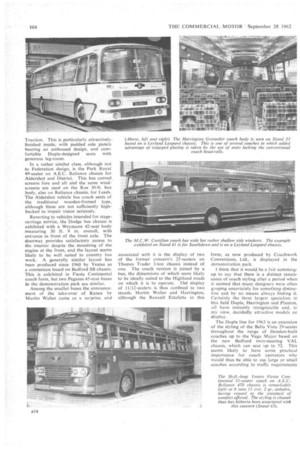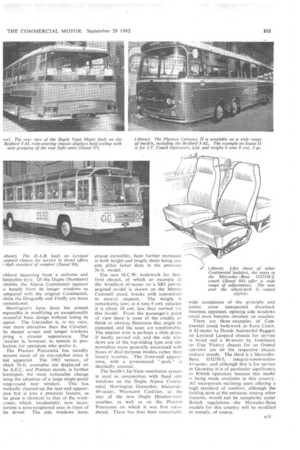My truck's on Tilrestoni
Page 108

Page 109

Page 110

Page 111

If you've noticed an error in this article please click here to report it so we can fix it.
he unladen weight is rather high in relaion to the length, at 8 tons 6 cwt. but his could no doubt be reduced with urther development.
Certainly there is plenty of evidence if increased interest in the appearance Lnd finish of double-deckers as well as ither passenger vehicles. The Liverpool :.'orimration version of the M.C.W.?tidied Leyland Atlantcan in my view ully justifies the expectations raised by ts design. This is perhaps because the orm of styling is applied consistently hroughout the design, and the basic promrtions, with equal-depth windows in ioth decks, are well balanced.
In the past few years it has become common practice to use frameless contruction for the front and rear dome vine's of double-deckers and to apply lo interior trim to them. The result has ieen an abrupt drop in standards from
• elatively neatly finished side windows to re ry spartan-looking end-sections. This las always seemed to me particularly 'logical at the front, since almost all )assengers face forward. The new 7ehicle for Liverpool incorporates framevork at both ends of the structure and he shape lends itself to simple and neat louble-skin roof panelling carried hrough to the ends. The pillars can be Lnd are much thinner, as well as being ietter finished.
The special Sunderland Corporation fersion of Roe bodywork for the Daimler Fleetline is another essay along similar ines, although I do not think it is quite is successful in appearance as the Liverpool vehicle, mainly because it is nose in the nature of a modification to an• existing design. A practical feature !ound on both Roe exhibits is the use of Oass-fibre seat backs which are vandalaroof and yet barely distinguishable in ippearance from feather-cloth.
A more orthodox approach to appear
ance is found in the Northern Counties body for Lancashire United on Daimler Fleetline chassis. This bodybuilder's original design for this chassis, introduced at last year's Scottish Show, was, in my view, one of the most attractive. looking vehicles of this kind, marred only by the rather fiat-fronted effect due to the lack of any bowing of the front panels common to most vehicles of this type. Advantage has now been taken of the new regulations and the appearance has been further improved at the insignificant cost of an increase of 3 in. in length.
All the Northern Counties bodies shown are particularly neatly finished inside and out, whilst a practical point is the complete elimination of any need to repaint the interior during the life of the vehicle, a feature which also applies to the Park Royal-bodied A.E.C. Renown, among other exhibits. This is achieved by the use of plastics, either in the form of complete panels or plastics-coated metal panels.
The only orthodox rear-entrance double-decker inside Earls Court is a Guy Arab IV 73-seater for Graham's Bus Service, of Paisley, on the Strachans stand. This also has an attractively finished interior, the anodized aluminium window finishers being durable as well as bright.
This is the first Earls Court Show at which 36-ft-long vehicles for the home market are exhibited, and some 15 complete single-deckers of this length for use in this country are displayed, in addition to four of approximately the same size for service abroad.
Four 36-ft. single-deckers, all based on Leyland Leopard chassis, are to B.E.T. Federation specification. The vehicle on the Weymann stand is for B.M,M.O. and is a 54-seat bus differing from the other three of these in having two steps between the entrance and the gangway, which slopes upward for the first few feet along its length whereas the others have three steps to a level gangway. Another 54-seat bus is on the Willowbrook stand and is for Western Welsh. It incorporates a luggage carrier iarge enough to deal with a folding pram in the interior, immediately behind the driver, The two seats displaced by this are replaced by the use of triple seats on one side of the gangway and double seats on the Other for two rows of seats towards the rear. The seating width afforded by these is somewhat meagre.
The Marshall exhibit is a 54-seater for Yorkshire (Woollen District) and although this is nominally a bus, the seats have slightly higher backrests than usual and it could undoubtedly be used on an express service over moderate distances. The most luxurious version of the same design is another Willowbrook exhibit, a 47-seat express coach for Yorkshire Traction. This is particularly attractively finished inside, with padded side panels bearing an embossed design, and comfortable Duple-designed seats with generous leg-room. . • In a rather similar class, although not to Federation design, is the Park Royal 49-seater on A.E.C. Reliance chassis for Aldershot and District. This has curved_ screens fore and aft and the same windscreens are used on the Roe 30-ft. bus body, also on Reliance chassis, for Leeds. The Aldershot vehicle has coach seats of the traditional wooden-framed type, although these are not sufficiently highbacked to impair vision seri:dusty.
Reverting to vehicles intended for stagecarriage carriage service, the Dodge bus chassis is exhibited with a Weyrnann 42-seat body measuring 30 ft. 9 in. overall, with entrance in front of the front axle. The doorway provides satisfactory access to the interior despite the mounting of the engine at the front, and the layout seems likely to be well suited to country bus work. A generally similar layout has been prod uc.ed since 1960 by Yeates as a conversion based on Bedford SB chassis. This is exhibited in Fiesta Continental coach form, but two Pegasus 45-seat buses in the demonstration park are similar.
Among the smaller buses the announcement of the take-over of Kenex by Martin Walter came as a surprise, and associated with it is the display of two of the former concern's 25-seaters on Thames Trader 3-ton chassis instead of one. The coach version is joined by a bus, the dimensions of which seem likely to be ideally suited to the Highland roads on which it is to operate. The display of 11112-seaters is thus confined to two stands, Martin Walter and Harrington, although the Renault Estafette in this
form, as now produced by Coachwork Conversions, Ltd., is displayed in the demonstration park.
I think that it would be a fair summingup to say that there is a distinct renaissance of coach styling after a period when it seemed that many designers were often groping uncertainly for something distinctive and by no means always finding it. Certainly the three largest specialists in this field Duple, Harrington and Plaxton, all have instantly recognizable and, in my view, decidedly attractive models on display.
The Duple line for 1963 is an extension of the styling of the Bella Vista 29-seater throughout the range of Hendon-built coaches up to the Vega Major based on the new Bedford twin-steering VAL chassis, which can seat up to 52. This seems likely to have some practical importance for coach operators who would thus be able to use large or small coaches according to traffic requirements vithout departing from a uniform and listinctive style. Of the Duple (Northern) xhibits, the Alpine Continental appears o benefit from its longer windows as ompared with the original Continental, vhilst the Dragonfly and Firefly are more onventional.
Harrington's have done the almost mpossibte in modifying an exceptionally uccessful basic design without losing its ,ppeal. The Grenadier is, in my view. yen more attractive than the Cavalier, he deeper screen and longer windows tiving a cleaner appearance. The :.'avalier is, however, to remain in proluction for operators who prefer it.
The Plaxton Panorama has steadily )ecome more of an eye-catcher since it irst appeared. The 1963 version„ of which 36-ft. examples are displayed on he A.E.C. and Plaxton stands, is further leveloped, the most noticeable change ving the adoption of a large single-panel wrap-round rear window. This has narkedly cleaned-up the rear-end appearince but is also a practical feature, as he glass is identical to that of the windizreen, which, incidentally, now ineor)orates a zone-toughened area in front of he driver. The side windows have, almost incredibly, been further increased in both height and length, there being one side pillar fewer than in the previous 36-ft. model.
The new M.C.W. bodywork for Bedford chassis, of which an example of the Amethyst 4I-seater on a SB3 petrolengined model is shown on the MetroCammell stand, breaks with convention in several respects. The weight is remarkably low; at 4 tons 9 cwt. unladen it is about 10 cwt. less than normal for this model. From the passenger's point of view, there is none of the crudity of finish or obvious flimsiness that might be expected, and the seats are comfortable. The interior trim is perhaps a little plain. if neatly carried out, and the side windows are of the top-sliding type and size nowadays more generally associated with buses or dual-purpose models rather than luxury coaches. The front-end appearance, with a pronounced "peak." is decidedly unusual.
The Smith's Jet-Vent ventilation system is used in conjunction with fixed side windows on the Duple Alpine Continental, Harrington Grenadier, Alexander 49-seater, Weymann Castilian, at the rear of the new Duple Hendon-built coaches, as well as on the Plaxton Panorama on which it was first introduced. There has thus been remarkably wide acceptance of the principle and unless some unexpected drawback becomes apparent, opening side.windows could soon become obsolete on coaches.
There are three examples of Continental coach bodywork at Earls Court. A 42-seater by Dansk Automobil Byggeri on Leyland Leopard chassis for service in Israel and a 46-seater by Jonkbeere on Guy Victory chassis for an Ostend operator are on the respective chassis makers' stands. The third is a MercedesBenz 032IH-L integral-construction 41-seater, and although this is for service in Germany it is of particular significance to British operators because this model is being made available in this country. All incorporate reclining seats offering a high standard of comfort, although the folding seats at the entrance, among other features, would not be acceptable under British regulations—the Mercedes-Benz models for this country will be modified to comply, of course.






































































































































































